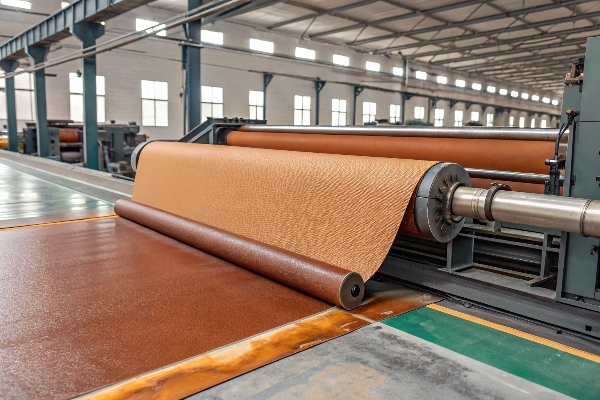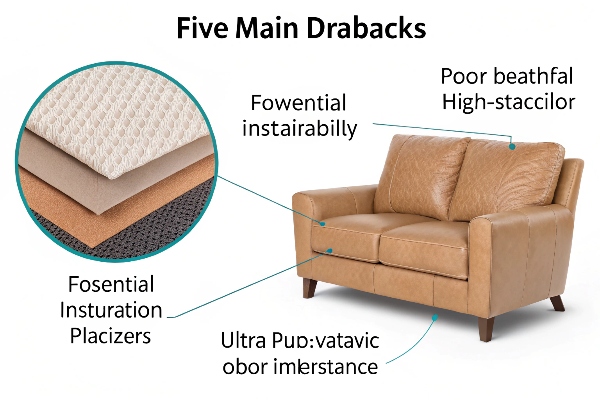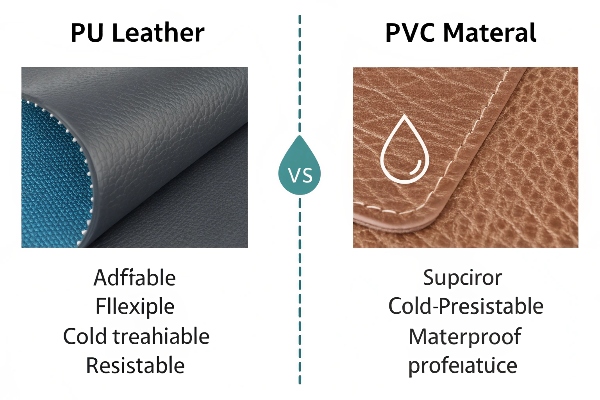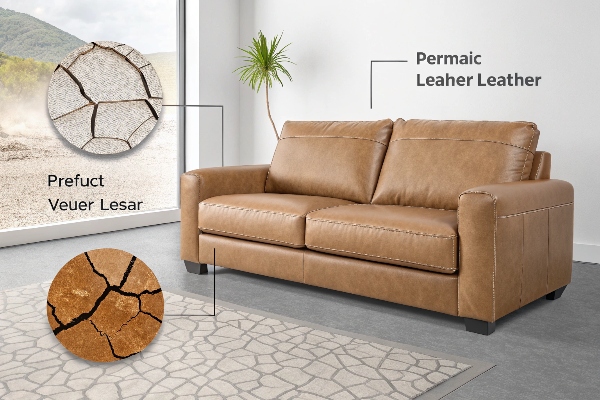I see many buyers stuck with material delays and cost overruns because they do not understand the basics of PVC leather. That confusion can freeze any project and drain budgets.
PVC leather is a synthetic material made from a woven base coated with poly-vinyl chloride. It contains no animal hide, yet it copies grain, color, and hand feel through embossing and additives. Buyers choose it for price, water resistance, and easy cleaning.

If you want your next sofa line, car seat, or fashion bag to launch on time, keep reading. I will break down myths, costs, and performance in plain words. The details below come from ten years of factory visits, lab tests, and client feedback.
Is PVC leather real leather?
Many catalogs still label PVC leather as “bonded” or “eco” leather, which tricks new buyers. That marketing fuzz can lead to warranty disputes and angry end users.
PVC leather is not animal leather. It starts with polyester or cotton fabric backed with foam, then coated with liquid vinyl. Heat and embossing add grain to mimic cowhide. No animal collagen exists in the final sheet, so it cannot be sold as genuine leather under truth-in-labeling laws.

Dive deeper: how PVC mimics hide yet stays synthetic
I learned this during a 2018 audit at a Guangdong mill. The line manager walked me through each oven zone. First, a doctor blade spreads plastisol over the fabric. Next, infra-red lamps gel the PVC. Finally, a steel drum imprints the grain.
Key Layers
| Layer | Main Content | Function |
|---|---|---|
| Base cloth | Polyester, cotton, or blended knit | Dimensional strength |
| Foam layer | PVC with blowing agent | Soft hand, loft |
| Skin layer | PVC plus pigments | Color, abrasion resistance |
| Topcoat | PU dispersion or acrylic | Gloss, stain block |
Each layer can change thickness, color mix, or plasticizer type. That flexibility lets me match price targets while staying inside REACH phthalate limits. Still, because no collagen fibers crosslink the structure, PVC leather will never age like full-grain hide. It will crack rather than form patina.
What are the disadvantages of PVC leather?
Clients love the low price tag, yet later complain about a sticky surface or brittle corners. This pain hurts brand image and sparks costly returns.
PVC leather has five main downsides: limited breathability, higher heat retention, potential plasticizer migration, odor during first weeks, and less tear resistance than microfiber PU. These limits matter for car interiors, baby furniture, or premium handbags.

Dive deeper: why the drawbacks appear and how to manage them
During a retrofit project for a Middle East bus fleet, I saw dashboards warp after only six months. The root cause was high cabin temperature and direct UV.
Disadvantage Breakdown
| Issue | Root Reason | Mitigation I Use |
|---|---|---|
| Poor breathability | Solid vinyl film blocks vapor | Add micro-perforation or switch to PVC/PU composite |
| Heat build-up | Dark pigments absorb IR, vinyl holds heat | Use IR-reflective pigments, lighter colors |
| Plasticizer bleed | Low-molecular weight phthalates migrate | Pick DOTP or bio-based plasticizers |
| Odor | Residual monomers | Extend airing time, activate carbon filtration in curing oven |
| Brittleness | Plasticizer loss, UV cuts chains | Add UV stabilizer, recommend shade parking |
I guide buyers through these fixes during sampling. Most accept a small cost uplift to protect brand value. If the product still demands luxe hand and air flow, I direct them toward microfiber PU instead.
Which is better, PU or PVC leather?
I often hear the question at fairs: “Jessie, which one should I pick?” Choosing wrong can waste tooling investments and lead to recall headaches.
PU leather outperforms PVC on breathability, softness, and cold crack resistance, yet PVC wins on price, flame retardancy, and water proofing. The “better” material depends on end use, climate, and budget.

Dive deeper: decision matrix for PU and PVC selection
In 2021 I helped a European sofa startup. They had a Nordic customer base that demanded vegan, soft-touch upholstery that stayed supple below 0 °C. We mapped key factors.
Comparison Table
| Factor | PU Leather | PVC Leather | Winner |
|---|---|---|---|
| Unit cost (USD/m²) | 4-8 | 2-4 | PVC |
| Breathability | Good | Poor | PU |
| Cold crack (-20 °C) | Pass | Fail | PU |
| Flame retardancy | Needs FR coat | Inherent | PVC |
| Weight | Light | Heavy | PU |
| Odor | Low | Medium | PU |
| Recyclability | Better | Limited | PU |
Selection Steps I Follow
- List critical performance specs (FR, cold crack, REACH).
- Rank them by “must-have” and “nice-to-have.”
- Match each spec to the table above.
- Request lab sheets from mills.
- Run real-use tests on prototypes for four weeks.
With this method the startup picked PU for seats and PVC for decorative panels, balancing touch and fire code. Small tweaks like this saved them 12% on total material cost.
How long does PVC leather last?
A big brand once dropped a PVC shoe line after buyers complained in year two. Longevity is the silent killer of repeat sales.
PVC leather lasts three to five years under normal indoor use, yet may crack within one year outdoors in sun and heat without stabilizers. With proper additives and gentle use, life can stretch to seven years.

Dive deeper: lifespan variables and testing methods
I always run accelerated aging when signing long-term supply deals. We expose swatches to UV-B lamps, heat cycles, and humidity swings. Results guide warranty terms.
Major Factors That Control Life
| Variable | Effect on Service Life | My Recommended Action |
|---|---|---|
| Plasticizer type | Fast migration shortens life | Use high-molecular or bio-based |
| UV exposure | Breaks polymer chains | Add UV-531 or HALS |
| Temperature | Speeds plasticizer loss | Specify cold crack -20 °C grade |
| Mechanical stress | Promotes surface cracks | Choose knit backing for flex |
| Cleaning chemicals | Strip topcoat | Use neutral pH cleaners |
Simple Field Test
- Bend the sample 180° ten times.
- Check for whitening or cracks.
- Place it in freezer (-10 °C) for 2 hours.
- Bend again and observe.
If cracks appear, reject the lot.
This quick test saved one of my African clients from buying 30,000 meters of sub-standard stock. They avoided a potential $50,000 warranty hit.
Conclusion
PVC leather is a cost-effective, water-proof choice when breathability or long life is not the top aim, while careful grade selection and additives can stretch performance to meet most mid-range needs.
